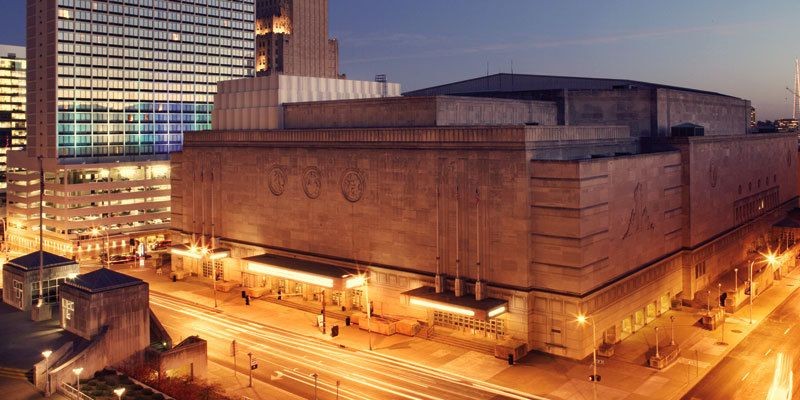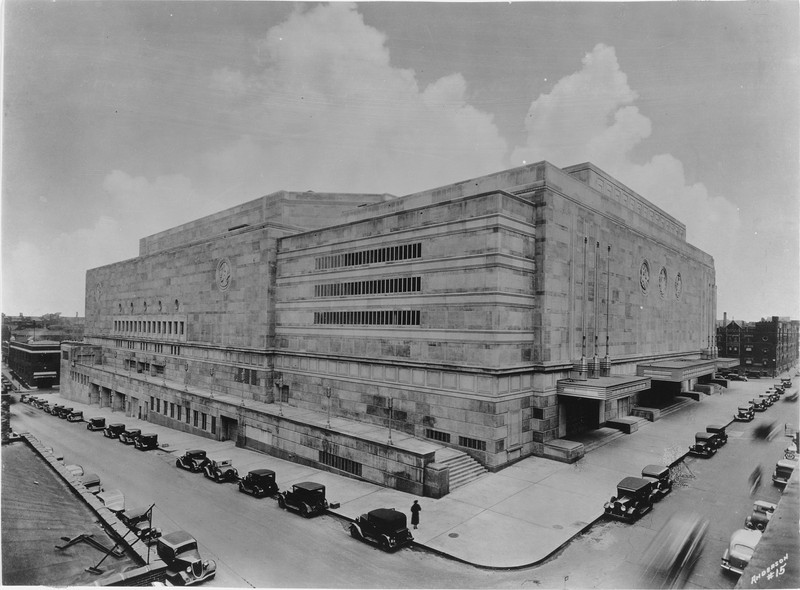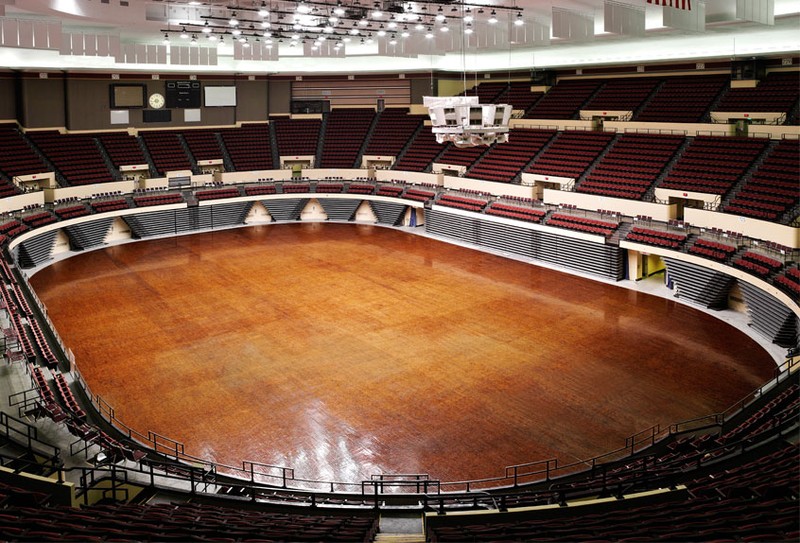Kansas City Municipal Auditorium
Introduction
Text-to-speech Audio
The Municipal Auditorium, nicknamed the Municipal, is a historic event center in Kansas City. The Art Deco structure was built in the 1930s as part of a Ten Year Plan to revive the city’s economy with construction jobs and new public buildings. Over the decades it has hosted many community and national events, including national basketball championship games and two speeches by Martin Luther King, Jr. Today, the historic structure is part of the overall Kansas City Convention Center Complex.
Images
The Art Deco-style Municipal Auditorium is a landmark structure in downtown Kansas City and has hosted numerous events. Image obtained from Visit KC.

The Municipal Auditorium sometime after its completion in the 1930s. Image courtesy of the Missouri Valley Special Collections.

The Municipal's arena has hosted many large events, most notably basketball games including NCAA and NAIA tournaments. Image obtained from the Kansas City Convention Center.

Backstory and Context
Text-to-speech Audio
The first convention hall in Kansas City was built and opened in February 1899. It was a grand building intended to represent the city's growth and host national events, but soon after its completion, the structure burned to the ground in April 1900. Just months later, a replacement hall was constructed in time for the city to host the Democratic National Convention. It soon became clear that this structure would not be large enough to suit the city’s needs, but voters rejected bonds to build a new one several times over the following years.
In the early 1930s, a Ten Year Plan was proposed to construct a series of public facilities in an effort to revive the city’s ailing fortunes during the Great Depression. The plan would provide jobs to many unemployed workers and create new buildings, including a municipal auditorium, city hall, and a county courthouse, to modernize the city and propel it forward. Much of the planning and support for the project was organized by the local political machine of Tom Pendergast. A $40 million bond for the Ten Year Plan was passed overwhelmingly in a special election in 1931.
The Municipal Auditorium was the first building to be constructed under the Ten Year Plan, and work began almost immediately after the bond was passed. Originally scheduled to be built in one year, the auditorium took six years to build and was $2 million over its $4.5 million budget. Two separate architectural firms were commissioned to design the Municipal Auditorium. The firm of Gentry, Voskamp & Neville handled the overall structure of the facility, while the firm of Hoit, Price, and Barnes designed the heating, air conditioning, and ventilation infrastructure. The auditorium was created in what is now known as the Streamline Moderne style of Art Deco architecture. The eleven-story structure was made primarily with limestone and stretched as wide as a city block. The Municipal Auditorium consists of four venues; a 10,000-seat arena, an exhibition hall, a music hall, and a little theater for smaller events. The exterior features decorations such as medallions, friezes, and flag poles.
Municipal Auditorium was formally dedicated in a ceremony on October 13, 1936, with President Franklin Roosevelt delivering the keynote address. Over the years it has hosted countless sporting events, concerts, speeches, rallies, dances, plays, meetings, and trade shows. Basketball games have notably been one of the most popular events at the Municipal. The arena hosted nine NCAA basketball championship games, and today it hosts both the Mid-America Intercollegiate Athletics Association tournament as well as the NAIA Men’s Division I Basketball National Tournament. It is currently home to teams such as the UMKC Kangaroos, the Kansas City Roller Warriors, and the Kansas City Tornados.
In September 1961, Martin Luther King Jr. delivered a speech at Municipal Auditorium to the attendees of the national meeting of the National Baptist Convention. The following year, King addressed a crowd of eight thousand at the Festival of Faith. Both speeches focussed largely on faith and religion, but in each address, King also denounced racial discrimination as incompatible with Christianity.
In recent years the Municipal Auditorium has undergone renovations twice, in 2007 and 2013. The changes include electrical upgrades, new seating, more ADA accessibility, and increased stage room.
Sources
Ford, Susan Jezak. “Municipal Auditorium.” The Kansas City Public Library. Accessed July 7, 2018. http://pendergastkc.org/article/buildings-orgs/municipal-auditorium
Gray, Meghan L. “Forgotten Landmark: The Municipal Auditorium of Kansas City, Missouri.” Master’s Thesis, University of Missouri-Kansas City, 2013.
“History.” Kansas City Convention Center. Accessed July 7, 2018. https://kcconvention.com/about/history/
“Kansas City Music Hall and Municipal Auditorium Kansas City, Mo.” Building Design & Construction. October 6, 2008. Accessed July 7, 2018. https://www.bdcnetwork.com/kansas-city-music-hall-and-municipal-auditorium-kansas-city-mo
Kerkhoff, Blair. “Municipal Auditorium, 80 years after doors opened, is rich in sporting history.” Kansas City Star. March 18, 2016. Accessed July 7, 2018. https://www.kansascity.com/sports/college/article66991432.html
“Municipal Arena.” Kansas City Convention Center. Accessed July 7, 2018. https://kcconvention.com/venue/municipal-arena/
Image 1: https://www.visitkc.com/business-detail/music-hall-municipal-auditorium
Image 2: Missouri Valley Special Collections
Image 3: https://kcconvention.com/image/municipal-arena-auditorium/
